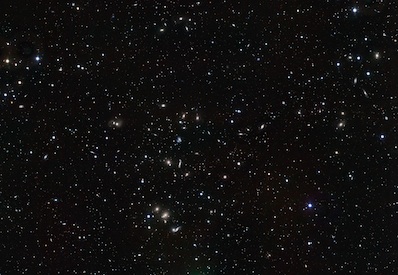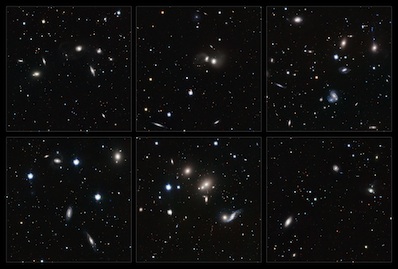


|

|
 |
|
Interacting galaxies abound in the Hercules cluster DR EMILY BALDWIN ASTRONOMY NOW Posted: 07 March 2012 The VLT Survey Telescope (VST) and its 268 megapixel camera OmegaCAM has unveiled plentiful interacting galaxies in the Hercules cluster.  Open larger image.This new image, taken with the VLT Survey Telescope (VST), spans a full square degree and was created from less than three hours of imaging time. Image: ESO/INAF-VST/OmegaCAM. Acknowledgement: OmegaCen/Astro-WISE/Kapteyn Institute. The Hercules galaxy cluster lies about 500 million light years away in the constellation of Hercules, and is rich in young star-forming spiral galaxies. The new portrait, captured in just three hours of imaging time using the 2.6 metre VST – the most recent addition to ESO's Paranal Observatory in Chile – reveals numerous interacting galaxies. After dancing around each other for millions of years these galaxies will eventually merge to create a number of single large galaxies.  Open larger image.Highlights of the Hercules galaxy cluster show a wide variety of interacting galaxies. Image: ESO/INAF-VST/OmegaCAM. Acknowledgement: OmegaCen/Astro-WISE/Kapteyn Institute. Galaxy clusters are formed when smaller groups of galaxies are drawn together by the attraction of their gravity. As the cluster becomes more compact, individual members of the group may encounter other galaxies, resulting in their eventual merger. Galactic collisions eventually strip spiral galaxies of their star-forming dust and gas, turning them into elliptical or irregularly shaped galaxies devoid of new star formation. At least three small clusters are thought to assemble the Hercules cluster, with itself merging with other large clusters to form a galaxy supercluster. The latest wide-field shot provides a new perspective of what is going on in the poorly-understood outskirts of this great galaxy metropolis. |
|
|
|
|